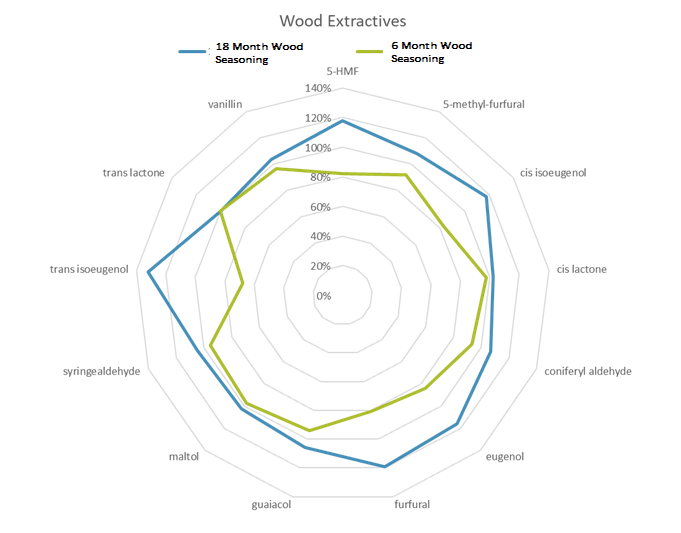Oak 101: Seasoning and Its Impact on Flavor Development
By Andrew Wiehebrink, Director of Spirit Research and Innovation
Distillers utilize numerous techniques to impart desirable and unique flavor profiles. That includes the different parameters that can be modified when ordering a new spirit barrel. At ISC, there are a multitude of different “flavor levers,” as I like to call them, that can be pulled to achieve distinct flavors among our barrels. Those levers fall under three main categories - seasoning, toasting and charring.
Let’s kick off the new year with a deeper look into seasoning.
Seasoning
Oak staves and heading should be seasoned for a minimum of 3-to-6-months, but the real differences begin to manifest when you go beyond that timeframe. Depending upon the distillery’s specifications, we offer an 18-month seasoned barrel and a 24-month seasoned barrel in addition to our classic 3–6-month seasoned barrel.
In my years in the industry, I have noticed that when folks talk about oak seasoning, the main benefit that usually gets discussed is the leaching or removal of tannins from the wood. While this is certainly true and undoubtedly advantageous for just about any scenario dealing with spirit maturation, this is not the most beneficial result of seasoning.
That honor belongs to the main byproduct of lignin and hemicellulose degradation that occurs during the seasoning period; and that byproduct is flavor. More seasoning = more flavor. The chemistry of seasoning is quite similar to that of toasting or charring in that during the time spent on the seasoning yard, the hemicellulose and lignin (which constitute roughly half of the physiological makeup of the oak staves) begin to degrade and form new and more favorable flavor components that can then be extracted into the spirit. I don’t think this is uncommon knowledge, especially for those who work in the spirits industry. However, I do think the significance of this phenomenon can be somewhat underestimated or perhaps more commonly, not quantified at all. See figure 1 below.

Figure 1. Bourbon Whiskey - 6-months vs 18-months of seasoning after one year in barrel
Figure 1 shows the difference in flavor component concentration when comparing whiskey aged one year in barrels constructed with 6-month seasoned wood (shown in green) versus 18-month seasoned wood (shown in blue). What we find is that during the first year of maturation, electing to move from our standard seasoning to a barrel with 18 months of seasoning yields a 32% boost in overall flavor concentration. That is a very significant jump in concentration. To put that in perspective, that is the equivalent to approximately 12 to 18 months of additional aging time in a young whiskey.
Couple the flavor boost with the ability of seasoning to reduce the amount of tannin within each stave, and you have a flavor lever that will benefit just about any application for any spirit. Good for longer aged spirits due to the reduced levels of tannin; good for younger spirits due to the 32% increase in flavor concentration within the first year.
Extra seasoning is good for any application involving aging or finishing a spirit of any kind, in any environment, at any age. This is why seasoning is one of my most important flavor levers.


